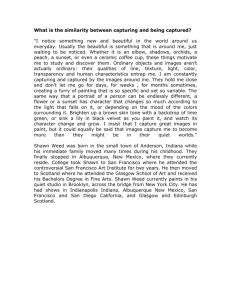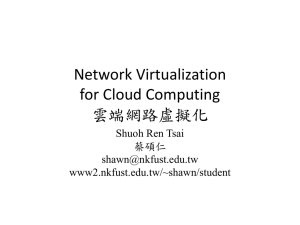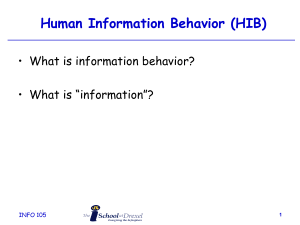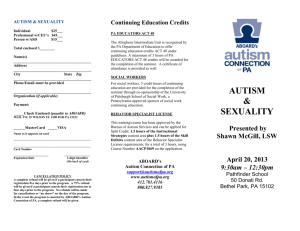PPT - The Career Center - Florida State University
advertisement
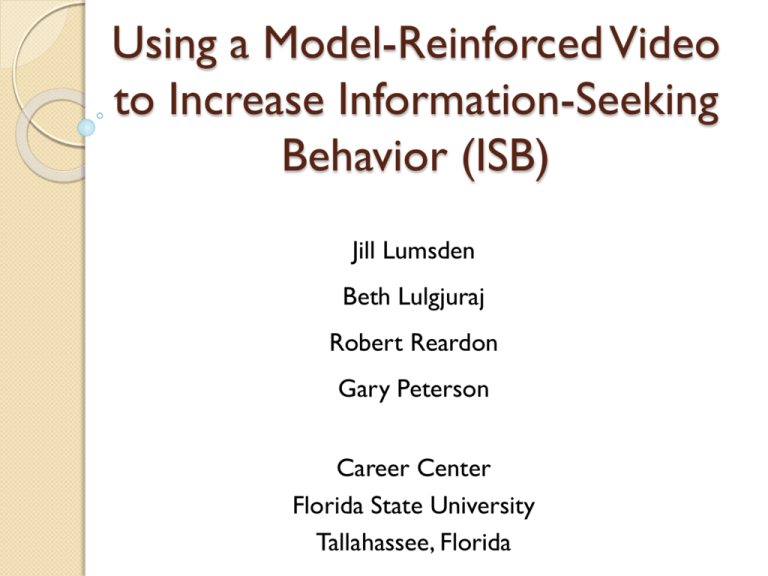
Using a Model-Reinforced Video to Increase Information-Seeking Behavior (ISB) Jill Lumsden Beth Lulgjuraj Robert Reardon Gary Peterson Career Center Florida State University Tallahassee, Florida Agenda Introductions Background & Purpose Show Video Actor Reflections & Process Evaluation Research Methods & Results Implications & Comments Elizabeth Ruff McHugh, PhD Background & Purpose Project history Documentation McHugh, E. R., Lenz, J. A., Reardon, R. C., & Peterson, G. W. (2012, April). The effects of using a model-reinforced video on information-seeking behaviour. Australian Journal of Career Development, 21(1), 14-21. Ruff, Elizabeth, “The Effects of Theory-Based Techniques and Media Tools on Information Seeking Behavior” (2010). Electronic Theses, Treatises and Dissertations. Paper 1931. Open Access. Also available at http://diginole.lib.fsu.edu/cgi/viewcontent.cgi?article=4385&context =etd. Research Background (examples) Fisher, T. J., Reardon, R. C., & Burck, H. D. (1976). Increasing information-seeking behavior with a model-reinforced video tape. Journal of Counseling Psychology, 23, 234-238. Jones, G. B., & Krumboltz, J. D. (1970). Stimulating vocational exploration through film-mediated problems. Journal of Counseling Psychology, 17, 107-114. Krumboltz, J. D., & Schroeder, W. W. (1965). Promoting career planning through reinforcement and models. Personnel & Guidance Journal, 44, 19-26. Information-Seeking Behavior 1. 2. 3. 4. 5. 6. Reading Writing Listening Visiting Observing Talking Script Visuals & Blocking Music Slide: FSU LOGO Slide: Career Center Slide: Exploring Options Music fades and is completely faded when Beth speak Set 1 Scene 1: Camera shows overall scene and slowly moves in when Beth starts to talk until complete close-up [superscript: Beth Lulgjuraj, Assistant Director [superscript: Educational & Career Planning] Camera defocuses scene Set 2 Change clothes Scene 2: Beth writing at desk. Camera: back of Shawn is shown as he walks up to the desk and signs in; overall view remains. Beth looks up and motions Shawn to sit. Shawn moves to chair and sits. Beth turns, faces Shawn, pulls her chair closer to Shawn. Camera: overall view showing both facing each other and side view. Script Spoken Lines Introduction [suggest shaded script on cue card] 1. Co: Hi. My name is Beth Lulgjuraj and I am an Assistant Director of the FSU Career Center for advising and counseling. We have a comprehensive program of services here, and in this presentation I’d like to highlight some ways that you might use our resources to make educational and career decisions. We’ll do this by showing you an interview with a student who was having difficulty in making a career decision. The interview is with Shawn, an FSU student. I think you will probably find it interesting to see how Shawn went about finding information that helped him. It is unlikely that you’ll have exactly the same interests as Shawn, but you will see how he went through the process of acquiring information. So let’s take a look at the interview now. [green shading indicates counselor (CO) talk] 2. ____________________________________ 3. Co: Hi Shawn! I’m Beth. What brings you in today? [shading indicates reinforcement] 4. Shawn: Well, I guess I have some questions about majors. [shading indicates client talk] 5. Co: O.k., tell me more about that. 6. Shawn: Well, I want to change my major and I’m really not sure what to go into. 7. Co: I see. What’s your major right now? 8. Shawn: I’m in sociology but the classes aren’t what I expected it to be so I’d like to get Production Facility and Support Digital Media Center Liz at Work Exploring Options Video Reflections on My Role Reinforce Information Seeking Behavior ◦ ◦ ◦ ◦ Modeling Verbal Nonverbal Visual 6 Types of ISB ◦ ◦ ◦ ◦ ◦ ◦ Write Observe Read Listen Visit Talk Additional Reflections Acting vs. counseling Things to consider You can do it too! Research Methods and Procedures Participants 10 class sections, 5 fall semester and 5 spring semester Sections randomly assigned to treatment and control conditions Treatment (N= 139), Control (N= 141) Participants • • • • • • 58% Male 58% Caucasian 23% African American 10% Hispanic 6% Asian 74% Upper division Dependent Variables • • • • • Number of research strategies (e.g., reading, writing, listening, visiting) Frequency of ISBs in above activities Hours spent in ISB Number of references used in research paper Number of types of references Procedures • • • • 6th day of class, career research paper Video Treatment validity check Last class, posttest Design and Analysis of Data • • • • • • Posttest only control group design Log transformation to normalize data Skew test LTEEV test MANOVA Univariate, pairwise comparisons Distributions for ISB1, ISB2, ISB3, and CFA2 Before and After Statistical Transformations ISB1 ISB2 ISB3 CFA1 CFA2 Raw Data 5.11/1.21=.24 205.18/72.26=2.89 221.02/78.33=2.82 3.142/7.86=.399 1.16/3.67=.32 Transformed .4/1.32=.3 .48/1.51=.32 .52/1.51=.34 .16/.92=.17 Raw Data -1.31 3.98 7.59 2.02 -.25 Transformed .92 .67 .34 -.99 -.27 Raw Data .000 .626 .015 .050 .042 Transformed .001 .348 .270 .039 .159 M/SD 3.60/1.3=.18 Skew LTEEV N = 280 ISB1 = Information-Seeking Behaviour Questionnaire six research strategies ISB2 = Information-Seeking Behaviour Questionnaire number of times engaged in ISB ISB3 = Information-Seeking Behaviour Questionnaire hours spent in ISB CFA1 = Career Field Analysis total number of references used CFA2 = Career Field Analysis number of types of resources used Univariate Comparison between Treatment and Control Groups ISB1 ISB2 ISB3 CFA1 CFA2 Treatment M 1.38 1.46 1.44 .93 3.90 Treatment SD .44 .50 .53 .14 1.06 Control M 1.25 1.56 1.58 .91 3.41 Control SD .34 .44 .49 .17 1.19 T 2.75 1.76 2.31 .97 3.62 Df 1 1 1 1 1 p-value .01** .08 .02* .34 .00*** Cohen’s D .33 .21 .28 .12 .43 effect-size r .16 .10 .14 .06 .21 Note: ISB1, ISB2, ISB3, CFA1, and CFA2 are transformed data (see Table 1) Computed using α= .05 * = .05 ** = .01 *** = .001 ISB1 = Information-Seeking Behavior Questionnaire (strategies) ISB2 = Information-Seeking Behavior Questionnaire (frequency) ISB3 = Information-Seeking Behavior Questionnaire (time) CFA1 = Career Field Analysis paper (number of references) CFA2 = Career Field Analysis paper (variety of types of references) Implications for Practice 1. 2. 3. 4. 5. 6. Website and self-help services Individual therapy Brief staff-assisted services Campus tours/orientation Evidence-based practice Beyond career services Conclusions 1. 2. 3. 4. What happened to modeling in counseling research and practice? A practical, efficient and effective intervention Video participants engaged in more ISB than nonparticipants Replicate using noncourse participants and examining diversity and gender of models For More Information www.career.fsu.edu/techcenter Questions/Comments

